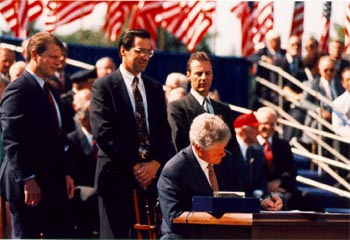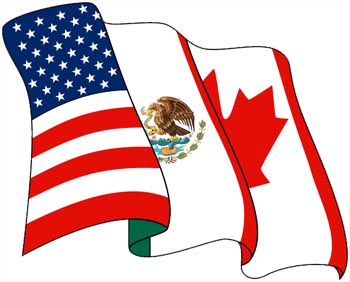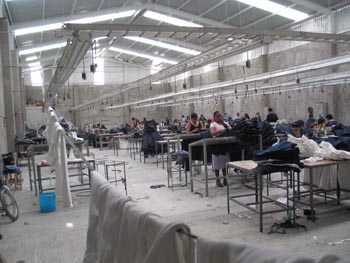International Affairs
 |
 |
 |
 |
 |
 |
 |
A Glimpse of NAFTA’s Goals
On January 1st, 1994, the North American Free Trade Agreement (NAFTA), came into effect. Its ostensible purpose: to facilitate free trade and economic growth between the North American countries of Canada, Mexico and the United States.
It meant the liberalization of the Mexican economy, the reduction of border tariffs between nations and a court established capable of ruling on economic matters that transcend any one of its constituent nations. This was the ideal of the treaty and it was brought to fruition by President Bill Clinton.
The political-economic reality
When it comes to analyzing international deals, we must consider not only what they say on paper, but also what the non-apparent intentions and realities behind them may be. A good example would be the Paris Peace Accord, which was a treaty signed with much fanfare in 1973 to end the Vietnam War, but which both sides knew was going to be immediately violated. In fact it was used as propaganda theater by both sides.
When analyzing political events, we must train ourselves to look deeper than the façade. We must scrutinize with a cunning eye the ulterior intentions that lay behind the written word.

 Prior to NAFTA a free trade agreement already existed between Canada and the United States. What NAFTA essentially did, then, was to bring Mexico into a closer relationship with the American and Canadian economies. NAFTA lowered Mexican tariffs on American goods and made Canada a larger market for Mexican exports.
Prior to NAFTA a free trade agreement already existed between Canada and the United States. What NAFTA essentially did, then, was to bring Mexico into a closer relationship with the American and Canadian economies. NAFTA lowered Mexican tariffs on American goods and made Canada a larger market for Mexican exports.
As such, the actual intention of NAFTA was not so much the establishment of free trade per se, but the admitance of Mexico into the pre-existing free trade system of the more advanced economies of Canada and the United States.
Mexico at the time was much less developed than its Northern associates. Much of its industrial and farming sectors were fairly antiquated, with 75,000 American Iowa farmers producing twice as much corn at half the cost of 3,000,000 Mexican corn farmers. One hope was that NAFTA would help spur the modernization of the Mexican economy.
Another hoped effect was to curb illegal immigration by providing more lucrative Mexican jobs. Further goals would be to achieve wage convergence for the Mexican workers that so lagged behind their Northern counterparts. Seen from this perspective it can be said that NAFTA was largely a treaty made with Mexico in mind, to bring Mexico up to speed in the global market.
As it stands today NAFTA did achieve certain degrees of success. The Mexican economy gained hundreds of thousands of auto jobs as American auto factories moved south of the border. In the U.S. cheaper products of Mexico became more freely available to the average consumer. Companies invested more across borders and overall trade activity, which is generally good for an economy, also increased.
The high cost
The measurable losses resulting from NAFTA require serious attention.
In Mexico millions of small farmers were put out of business by the subsidized commercial agriculture industry of the United States. Mexican unemployment rose, poverty remains unchanged and, contrary to expectations, illegal immigration more than doubled (1). The increased migration of farm workers to the cities caused complaints that this left the countryside in the hands of drug cartels.
Domestic industries were dismantled and converted to maquiladoras, that is to say, factories owned by multinational corporations that take imported materials, assemble them exploiting lower labor costs and regulations and, then, export them to a wealthier country to be sold for a much higher price. (2)

 The great economic convergence between Mexico and its Northern associates thus failed to materialize. In many ways NAFTA left Mexican labor and natural resources vulnerable to exploitation by foreign corporate interests at the expense of real economic growth and individual quality of life. (3)
The great economic convergence between Mexico and its Northern associates thus failed to materialize. In many ways NAFTA left Mexican labor and natural resources vulnerable to exploitation by foreign corporate interests at the expense of real economic growth and individual quality of life. (3)
North of the Mexican border, the United States saw an increase in jobs due to trade, but also saw increasing devastation of its industrial factory production. Factories closed across the U.S.
While money was added to the economy in some ways, the United States also ran an increasing trade deficit. With the explosion of trade following the implementation of NAFTA, the meager trade surplus that the U.S. had started to achieve from 1991 plummeted to trade deficits numbering in the tens of billions of dollars.
The economy became more active, but the number of both winners and losers grew expotentally. While some sectors benefited greatly, others suffered painfully.
If one were to create an analogy for NAFTA, he could imagine a man who had a certain amount of money. He starts making trades involving large amounts of dollars and options. In the end he has in hand less money than he started with, even though many goods and services were traded in all directions with his neighbor.
This can apply to NAFTA on a national scale. The opening of the markets between Mexico and the North caused more economic activity, but at a great cost. Perhaps one of the most under-represented costs is the destruction of the traditional lifestyle of so many Mexicans that had heretofore lived organically independent of the modern world at large.
Globalism
We live in the era of increasing globalization. The steady interlinking of nations as well as the erosion of traditional modes of living are inexorable components of the Revolution marching constantly towards a universal order. This is proper to the Revolution, the revolt analyzed and opposed by such great minds as Dr. Plinio Corrêa de Oliveira, and it is carried to all spheres of human existence: the social, political and economic.
This process can be seen unfolding globally, from the European Union to the Mercosur to the agreements and treatises with Asia. In the grand scheme of things NAFTA is just one component of this process. It is a stepping stone that leads to globalization.
By the principle of gradualism, the Revolution proceeds by a slow series of victories. While the recent political elections in the United Sates present what seems to be a backlash against the progress of the Revolution, it must be remembered that until a true organic and moralized society is establish, the Revolution's march continues one way or another.
Even if NAFTA is repealed and the authentic political right wins victories across the board, this will present merely a stumbling block to the Revolution. It is only a matter of time before the Revolution adapts again in its relentless march towards the realization of its end game: the integration of nations into an absolute global union.

It meant the liberalization of the Mexican economy, the reduction of border tariffs between nations and a court established capable of ruling on economic matters that transcend any one of its constituent nations. This was the ideal of the treaty and it was brought to fruition by President Bill Clinton.
The political-economic reality
When it comes to analyzing international deals, we must consider not only what they say on paper, but also what the non-apparent intentions and realities behind them may be. A good example would be the Paris Peace Accord, which was a treaty signed with much fanfare in 1973 to end the Vietnam War, but which both sides knew was going to be immediately violated. In fact it was used as propaganda theater by both sides.
When analyzing political events, we must train ourselves to look deeper than the façade. We must scrutinize with a cunning eye the ulterior intentions that lay behind the written word.

Bill Clinton, above, signs NAFTA, opening the economy between the three North American countries

As such, the actual intention of NAFTA was not so much the establishment of free trade per se, but the admitance of Mexico into the pre-existing free trade system of the more advanced economies of Canada and the United States.
Mexico at the time was much less developed than its Northern associates. Much of its industrial and farming sectors were fairly antiquated, with 75,000 American Iowa farmers producing twice as much corn at half the cost of 3,000,000 Mexican corn farmers. One hope was that NAFTA would help spur the modernization of the Mexican economy.
Another hoped effect was to curb illegal immigration by providing more lucrative Mexican jobs. Further goals would be to achieve wage convergence for the Mexican workers that so lagged behind their Northern counterparts. Seen from this perspective it can be said that NAFTA was largely a treaty made with Mexico in mind, to bring Mexico up to speed in the global market.
As it stands today NAFTA did achieve certain degrees of success. The Mexican economy gained hundreds of thousands of auto jobs as American auto factories moved south of the border. In the U.S. cheaper products of Mexico became more freely available to the average consumer. Companies invested more across borders and overall trade activity, which is generally good for an economy, also increased.
The high cost
The measurable losses resulting from NAFTA require serious attention.
In Mexico millions of small farmers were put out of business by the subsidized commercial agriculture industry of the United States. Mexican unemployment rose, poverty remains unchanged and, contrary to expectations, illegal immigration more than doubled (1). The increased migration of farm workers to the cities caused complaints that this left the countryside in the hands of drug cartels.
Domestic industries were dismantled and converted to maquiladoras, that is to say, factories owned by multinational corporations that take imported materials, assemble them exploiting lower labor costs and regulations and, then, export them to a wealthier country to be sold for a much higher price. (2)

Maquiladora factories import raw materials tariff-free to exploit cheaper labor; below, a campesino living from his land, a rapidly disappearing scene

North of the Mexican border, the United States saw an increase in jobs due to trade, but also saw increasing devastation of its industrial factory production. Factories closed across the U.S.
While money was added to the economy in some ways, the United States also ran an increasing trade deficit. With the explosion of trade following the implementation of NAFTA, the meager trade surplus that the U.S. had started to achieve from 1991 plummeted to trade deficits numbering in the tens of billions of dollars.
The economy became more active, but the number of both winners and losers grew expotentally. While some sectors benefited greatly, others suffered painfully.
If one were to create an analogy for NAFTA, he could imagine a man who had a certain amount of money. He starts making trades involving large amounts of dollars and options. In the end he has in hand less money than he started with, even though many goods and services were traded in all directions with his neighbor.
This can apply to NAFTA on a national scale. The opening of the markets between Mexico and the North caused more economic activity, but at a great cost. Perhaps one of the most under-represented costs is the destruction of the traditional lifestyle of so many Mexicans that had heretofore lived organically independent of the modern world at large.
Globalism
We live in the era of increasing globalization. The steady interlinking of nations as well as the erosion of traditional modes of living are inexorable components of the Revolution marching constantly towards a universal order. This is proper to the Revolution, the revolt analyzed and opposed by such great minds as Dr. Plinio Corrêa de Oliveira, and it is carried to all spheres of human existence: the social, political and economic.
This process can be seen unfolding globally, from the European Union to the Mercosur to the agreements and treatises with Asia. In the grand scheme of things NAFTA is just one component of this process. It is a stepping stone that leads to globalization.
By the principle of gradualism, the Revolution proceeds by a slow series of victories. While the recent political elections in the United Sates present what seems to be a backlash against the progress of the Revolution, it must be remembered that until a true organic and moralized society is establish, the Revolution's march continues one way or another.
Even if NAFTA is repealed and the authentic political right wins victories across the board, this will present merely a stumbling block to the Revolution. It is only a matter of time before the Revolution adapts again in its relentless march towards the realization of its end game: the integration of nations into an absolute global union.
- Weisbrot, Mark, Stephan Lefebvre, and Joseph Sammut. Did NAFTA Help Mexico? An Assessment After 20 Years. 1st ed. Washington, DC: Center for Economic and Policy Research, 2014. Web. 15 Feb. 2017
- Ibid.
- Ibid.

Posted February 15, 2017
______________________
______________________
 Volume I |
 Volume II |
 Volume III |
 Volume IV |
 Volume V |
 Volume VI |
 Volume VII |
 Volume VIII |
 Volume IX |
 Volume X |
 Volume XI |
 Special Edition |


